The North Karelia Project fundamentally changed the lifestyle of Finns and increased healthy years of life
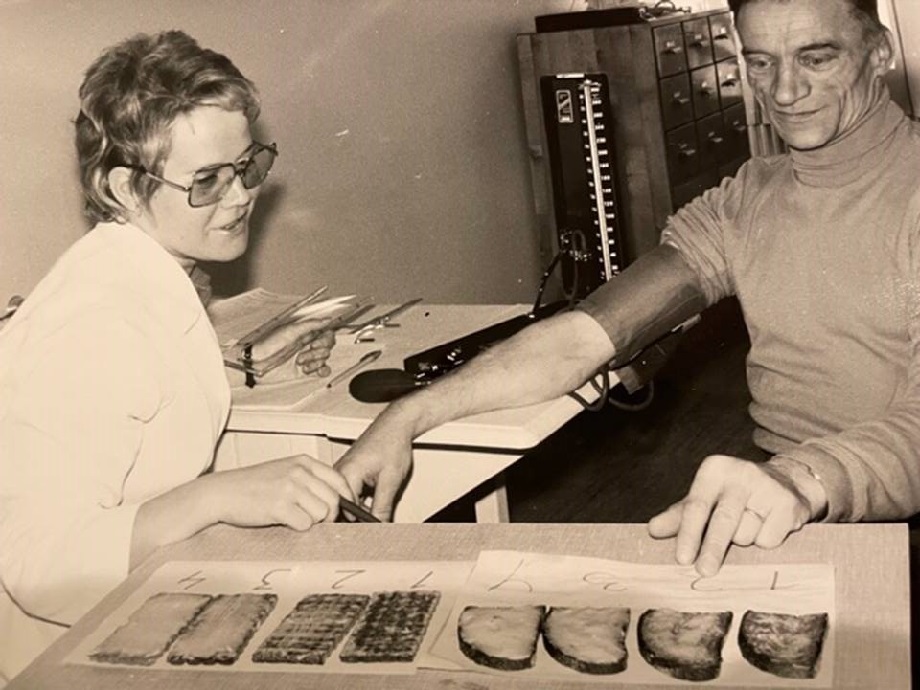
The North Karelia Project, which began 50 years ago, had a revolutionary impact on the lifestyle and health of Finns.
The North Karelia Project was launched in the early 1970s, at a time when the health situation in Finland – and North Karelia in particular – was very concerning. Coronary heart disease mortality among men was the highest in the world, a lot of young men were dying and the life expectancy for men was less than 65 years. The project focused on the most important risk factors affecting coronary mortality and health. The aim was to reduce smoking and lower serum cholesterol and blood pressure levels. From the outset, the goal was to lower cholesterol and blood pressure through dietary changes, including a reduction in the use of butter and salt.
A quick impact on population health
Lifestyle changes led to a rapid decrease in the coronary heart disease mortality rate of the population in North Karelia and gradually throughout the entire country. Since 1972, annual premature coronary mortality among men of working age has fallen by more than 80 per cent. As a result of dietary changes, the population's cholesterol level has fallen by more than 20 per cent. Smoking among men has declined significantly, and mortality due to smoking-related cancers has decreased by more than 50 per cent in comparison to the post-war situation. The changes have shifted to increasingly older age groups, thus supporting healthy ageing.
- The most important outcome of the project is a massive reduction in cardiovascular disease mortality. Although I believed that changes would happen when the project began, I never imagined that the change in chronic national diseases would be so huge after a few decades. The most significant change was in lifestyles, food quality and smoking, which changed very much in accordance with the project goals, says Pekka Puska, Director of the North Karelia Project.
Positive development in blood pressure levels since 1972
As a general rule, blood pressure is normal when it is less than 130/85 millimetres of mercury (mmHg). Elevated blood pressure is the most significant global risk factor in terms of reducing healthy years of life. When blood pressure increases, the risk of death from coronary artery disease or stroke also rises. At the same time, the risk of atrial fibrillation or heart failure also increases.
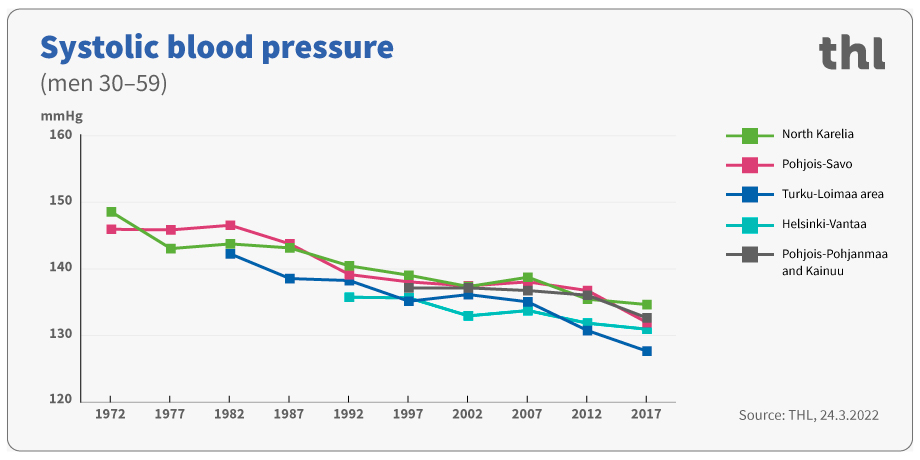
Systolic blood pressure (men 30-59).
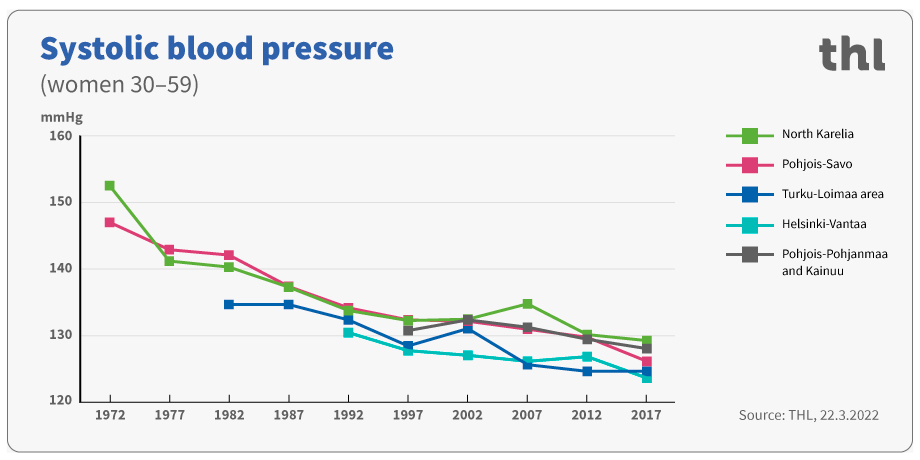
Systolic blood pressure (women 30-59).
Systolic blood pressure (the upper reading) has dropped in men and women throughout the country since 1972. Although the average blood pressure of the population is approaching the recommended level, a significant segment of the population still has blood pressure that is above the recommendation.

Diastolic blood pressure (men 30-59).
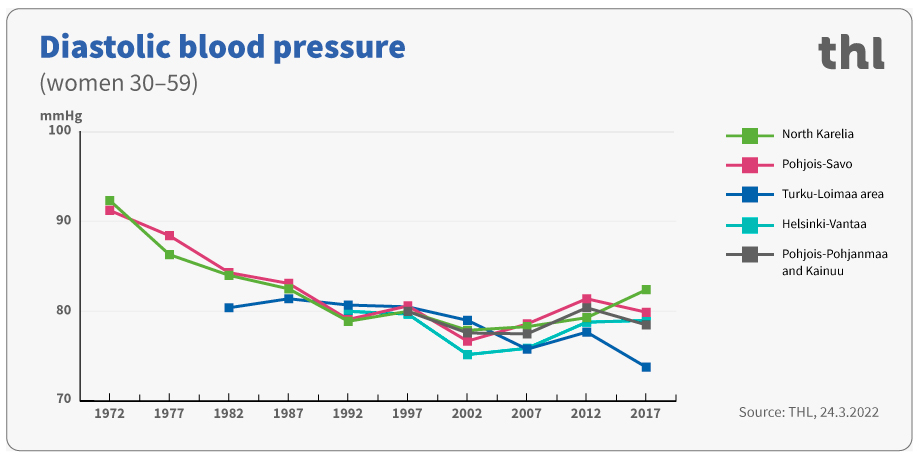
Diastolic blood pressure (women 30-59).
Starting in 1972, diastolic blood pressure (the lower reading) fell rapidly in both men and women until the decrease began levelling out in the early 1990s. The reason for this levelling out may be an increase in overweight and obesity.
Dietary changes reflected as a decrease in cholesterol values
According to recommendations, total cholesterol levels should be under 5 mmol per litre (mmol/l), and the value for bad LDL cholesterol less than 3.0. However, the overall risk also depends on other risk factors affecting the blood vessels, such as smoking, blood pressure and a lack of physical activity.

Serum cholesterol (men 30-59).
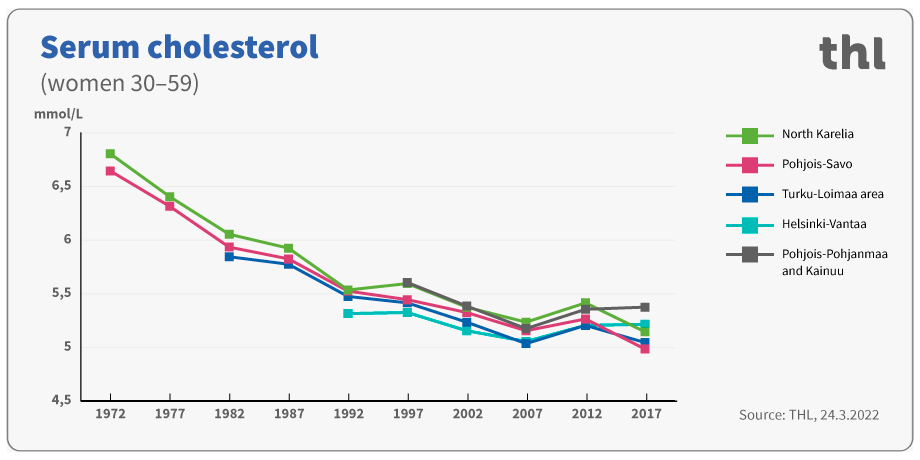
Serum cholesterol (women 30-59).
Changes in eating habits have caused a steady decrease in cholesterol values in both men and women between 1972 and 2017.
Heavy consumption of hard fats increases serum cholesterol concentration, especially the LDL cholesterol that increases the risk of coronary heart disease. Replacing hard fat with soft vegetable fat reduces the risk of coronary artery disease.
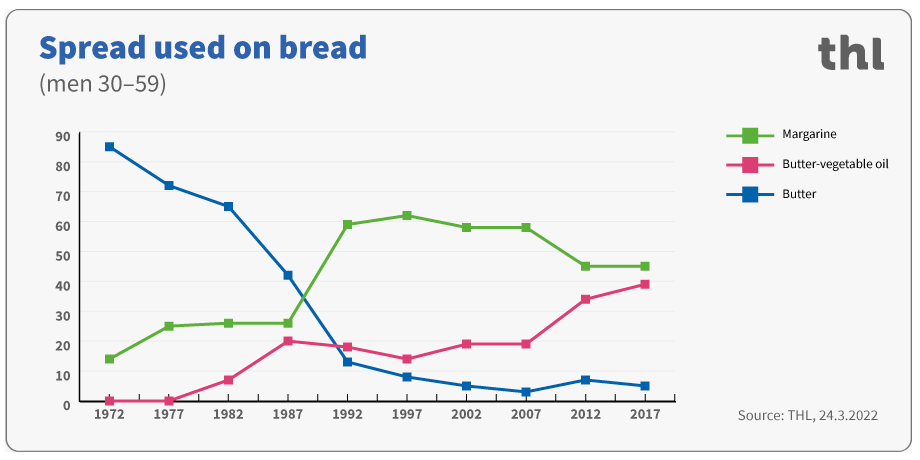
Spread used on bread (men 30-59).
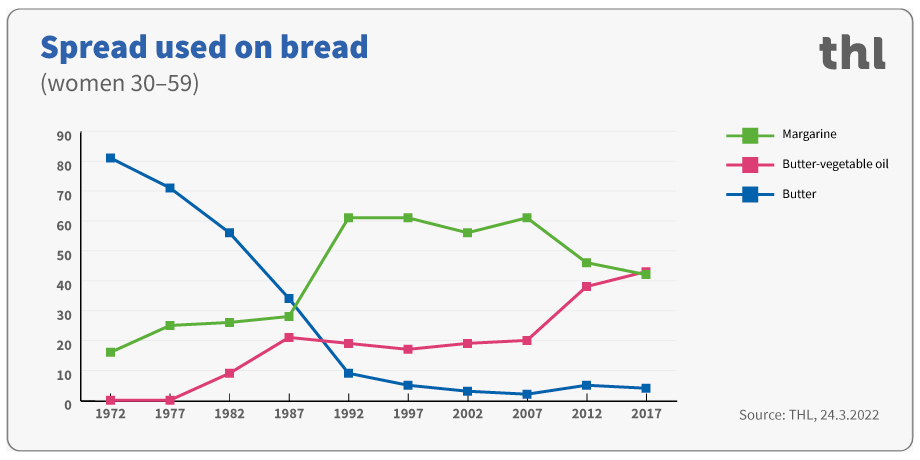
Spread used on bread (women 30-59).
The use of vegetable oils in cooking and on bread has increased, while the use of butter has decreased since 1972.
Life expectancy has increased at a steady pace
Life expectancy refers to the number of years that people born in a given period would live on average if mortality remained unchanged in all age groups. Life expectancy in Finland has been increasing since the 1870s. In 2020, the life expectancy was 79 years for Finnish men and 85 years for women.
.jpg/e2fd5048-c158-fcc5-0d66-3e11396d4d3c?t=1648631310244)
Life expectancy in Finland 1971-2020.
Life expectancy increased among both men and women in Finland between 1971 and 2020.
The large decrease in premature mortality means that Finnish men have gained approximately 13 and women more than 10 additional years of mostly healthy life since 1972.
The work to promote population health continues
When the North Karelia Project began, it was initially coordinated by the University of Kuopio. A new unit was set up at the university in 1976 and Pekka Puska, Director of the North Karelia Project, became head of that unit. The Public Health Institute (KTL) coordinated the study between 1982 and 2008 . The Finnish Institute for Health and Welfare (THL), established in 2009 to continue the work of KTL, is currently responsible for monitoring and studying population health.
- During the project, our small core group toured the region actively for many years and met representatives from health care, municipalities, NGOs and business life – always with the aim of promoting the project targets. We also met the population at, for example, Heart evenings, market events and store events. We held a variety of training sessions and maintained close contact with the media, says Pekka Puska as he describes the field work that took place during the project.
The experiences from the project and its methods have been utilised nationally. For example, the monitoring of project results that began in 1972 has expanded into the national FINRISK study, which collected data on chronic non-communicable diseases among the Finnish population.
The North Karelia health behaviour surveys were used to create the national Health Behaviour among the Finnish Adult Population Survey, which monitored the health and lifestyles of the working age population between 1978 and 2014. Since then, monitoring has continued as THL’s FinSote survey.
- The evaluation studies from the North Karelia project have provided a foundation for developing national population health monitoring surveys. On an international scale, Finland has the longest-term trend monitoring of key risk factors for cardiovascular diseases and many other chronic illnesses, explains Director of Department, Professor Tiina Laatikainen from THL.
The project methods have been utilised in public health work, for example, when developing diabetes and memory disorder prevention intervention studies and planning the Finnish Allergy Programme, which were coordinated by THL.
As a result of the North Karelia Project, international cooperation with, for example, the World Health Organisation (WHO) had an impact on international developments in the field and opened up new paths for disseminating research data.
- The North Karelia Project has been the flagship for a major change in public health that has been part of Finland's post-war development into a welfare state. As a result of the project, we have played an important international role in the prevention of non-communicable diseases, says Puska.
The 50th anniversary of the North Karelia Project
Wednesday 6 April 2022, from 13:30 to 16
Joensuu Conservatory, Yliopistonkatu 4
Organiser: North Karelia Centre for Public Health
Free of charge
PROGRAMME
Opening remarks
Professor Tiina Laatikainen, Director of Department (THL), Chair of the North Karelia Project Foundation
Message from the State
Minister Aki Linden
Message from a regional representative
Member of Parliament Anu Vehviläinen
Music: Set`Akat: Sari Kaasinen, Mari Kaasinen and Karoliina Kantelinen
Public health yesterday, today and tomorrow
Director General Markku Tervahauta, Finnish Institute for Health and Welfare (THL)
Greetings from the Finnish Heart Association
Secretary General Marjaana Lahti-Koski, Finnish Heart Association
North Karelia Project around the world -video
International speech
Dr. Ala Alwan, former Assistant Director General at WHO, Geneva
Music: Set`Akat
Recollections from project veterans -video
Closing remarks
Professor Pekka Puska, Director of the North Karelia Project
Karjalaisten laulu (Song of the Karelians)
Master of Ceremonies: Dr. Juhani Wiio
Further information
Professor Pekka Puska, Director of the North Karelia Project, [email protected], tel. +358 40 771 5571.
Professor Tiina Laatikainen, Director of Department (THL), Chair of the North Karelia Project Foundation, [email protected], tel. +358 40 549 6682.



